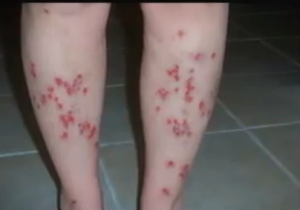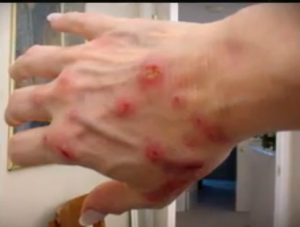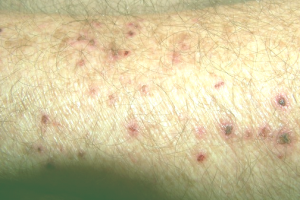Morgellons disease is a mystifying skin disease that results in non-healing sores and lesions leading to disfigurement, in addition to strange sensations of creeping, biting, stinging and crawling on or under the skin.
There is no accepted definition of Morgellons disease which withstands medical ratification. Despite the absence of a medical diagnosis, the Centers for Disease Control and Prevention or the CDC in the United States, is examining the disease and its causes. CDC considers Morgellons disease as unexplained dermopathy.
Morgellons disease first came into the limelight when Mary Leitao, a woman from Pittsburgh, gave a detailed description of skin sores and thin filamentous structures that grew from within her son’s skin, on her website. Soon, her inbox was flooded with emails from thousands of individuals who were experiencing similar symptoms.
This gave rise to the Morgellons Research Foundation which has lobbied for research on the disease. Mary Leitao, was the one to name the disease. She borrowed the name from some seventeenth century French doctors who had seen similar symptoms in children.
Symptoms of Morgellons disease
Since, Morgellons disease is not a widely accepted medical condition, there are no uniformly accepted signs and symptoms. Physicians classify the symptoms listed below as delusions and part of some psychiatric disorder.
As per the Morgellons Research Foundation, some of the signs and symptoms of Morgellons disease are as follows:
- Individuals may report and experience the presence of fine thread-like filaments on and in the skin lesions. Sometimes, these filaments may eject or emerge from skin that appears intact and normal. These filamentous fibers tend to have varied colors but some of the commonly described colors include red, black, blue and white. The fibers are microscopic in size and their clinical visualization requires the use of a heavy microscope. These filaments may exhibit fluorescence created by ultraviolet light. Some patients may also report the presence of white or black colored sand-like granules on the clothing as well as on and in the skin
- Sensations of movement on or beneath the surface of the skin may also be reported by the patients of Morgellons disease. These sensations are sporadic and are more often described as stinging, crawling, moving or biting. These sensations may be felt on any part of the body’s skin, but are generally limited to the scalp, the nasal passages, the face, the ear canals and the lower legs below the knees.
- Lesions may appear spontaneously or may be caused due to self injury that the patients may engage in while trying to relieve intense itching and pain. The self generated lesions may appear as linear or as damage to the skin due to ‘picking’. The spontaneously appearing lesions look like pimples or hives and without a center, which is white. These lesions may become open wounds that heal very slowly causing heavy pigmentation or they may seal themselves with a thick and gelatinous outer layer. Skin lesions may be chronic and persist for several years.
- Presence of pain and other musculoskeletal effects become visible in various ways. Such pain tends to get distributed over a broad area that includes the tendons, muscles, the joints, as well as connective tissues. Headaches that are vascular as well as ‘pressure’ oriented and pain in the vertebrae are common. Also, there may be signs of premature degeneration of vertebrae on both discs.
- Aerobic limitation is widespread and significant enough to inhibit the daily activities. Most of the patients experience increased fatigue and meet the Fukuda Criteria for Chronic Fatigue Syndrome as well. The cardiology data of patients and regularly elevated heart rates suggest a chronic myocarditis that results in a lowered cardiac output, which has been slightly compensated for by Starling’s Law.
- There is presence of cognitive deficits and dysfunction like hampering of processing of signs by the frontal lobe, logical thinking deficits, short-term memory deficits as well as attention abnormalities. All the cognitive deficits can be psychologically measured
- Most patients also experience alterations and deficits of the emotional effects. These deficits can range from mild to severe and can hamper daily life. Emotional deficits include limitation or loss of boundary control and intermittent obsession-filled states.
- Persistent and ever changing vision problems such as frequent change of prescription glasses, perceived alterations in visual field as well as light intensity
- Presence of gastrointestinal disorder symptoms such as bowel habit changes, difficulty in swallowing, gastroesophageal reflux, etc.
- The presence of several neurological symptoms such as peripheral neuropathy, abnormal reflexes and repetitive abnormalities of brain control that affect motor function, respiratory rate, circadian rhythm, etc.
Causes of Morgellons disease
- There are no known causes of Morgellons disease that are medically accepted and ratified.
- Most of the symptoms of Morgellons disease are considered to be similar to a delusional disorder known as delusional parasitosis
- Based on the data currently available, there are research studies being conducted to find out the causes of Morgellons disease. The CDC is at the forefront of this research.
Treatment of Morgellons disease
- There are no known treatment methods for Morgellons disease.
- Patients can be treated and given therapy on the basis of delusional parasitosis diagnosis
- The other symptoms may be treated on individual basis
- It is essential that patients continue to visit physicians in order to reduce the problematic symptoms of Morgellons disease
Morgellons disease pictures


